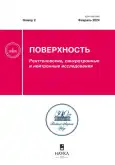The Effect of Thermal Action on the Change in the Chemical Composition of the Surface Layers of a Titanium Alloy, with a Sprayed Carbon Film, after Irradiation with N+ Ions
- Authors: Vorobyov V.L.1, Bykov P.V.2, Gilmutdinov F.Z.2, Bayankin V.Y.2, Pospelova I.G.3, Kobziev V.F.4
-
Affiliations:
- 1Udmurt Federal Research Center UB RAS
- Udmurt Federal Research Center UB RAS
- Udmurt State Agricultural University
- Udmurt State University
- Issue: No 2 (2024)
- Pages: 11-17
- Section: Articles
- URL: https://gynecology.orscience.ru/1028-0960/article/view/664772
- DOI: https://doi.org/10.31857/S1028096024020029
- EDN: https://elibrary.ru/BFNAPG
- ID: 664772
Cite item
Abstract
The effect of thermal exposure under high vacuum conditions on the chemical composition of the surface layers of the VT6 alloy with mixed implantation of N+ ions by a carbon film is investigated. It is shown that under the conditions of thermal exposure, the change in the concentration profiles of the distribution of elements is determined by the processes of chemical interaction, in which the diffusion of carbon and nitrogen into deeper layers does not occur. On the contrary, their concentration decreases and this is due to the formation of volatile compounds CO, CO2 or (CH)2 under thermal exposure. Titanium in the surface analyzed layer is in an oxidized state with various degrees of oxidation. Up to a depth of about 10 nm, the oxidation state of titanium is Ti4+ and Ti3+, and in the transition region of the film/substrate is Ti2+.
Full Text
About the authors
V. L. Vorobyov
1Udmurt Federal Research Center UB RAS
Author for correspondence.
Email: Vasily_L.84@udman.ru
Russian Federation, Izhevsk
P. V. Bykov
Udmurt Federal Research Center UB RAS
Email: bykovpv@udman.ru
Russian Federation, Izhevsk
F. Z. Gilmutdinov
Udmurt Federal Research Center UB RAS
Email: Vasily_L.84@udman.ru
Russian Federation, Izhevsk
V. Ya. Bayankin
Udmurt Federal Research Center UB RAS
Email: Vasily_L.84@udman.ru
Russian Federation, Izhevsk
I. G. Pospelova
Udmurt State Agricultural University
Email: Vasily_L.84@udman.ru
Russian Federation, Izhevsk
V. F. Kobziev
Udmurt State University
Email: Vasily_L.84@udman.ru
Russian Federation, Izhevsk
References
- Rajabi A., Ghazali M.J., Daud A.R. // Material. Design. 2015. V. 67. P. 95. https://doi.org/10.1016/j.matdes.2014.10.081
- Калита В.И., Комлев Д.И., Прибытков Г.А. и др. // Физика и химия обработки материалов. 2018. № 3. С. 16. https://doi.org/10.30791/0015-3214-2018-4-16-27
- Сивков А.А., Герасимов Д.Ю. // Физика и химия обработки материалов. 2017. № 3. С. 33.
- Komarov F.F., Konstantinov V.M., Kovalchuk A.V. et al. // Wear. 2016. V. 352. P. 92. https://doi.org/10.1016/j.wear.2016.02.007
- Андриевский Р.А. // Успехи химии. 2005. Т. 74. С. 1163.
- Hauert R., Patscheilder J. // Advanced Engineering Materials. 2000. V. 2. Iss. 5. P. 247. http://dx.doi.org/10.1002/(SICI)1527-2648(200005) 2:53.0.CO;2-U
- Kalin B.A., Volkov N.V., Oleinikov I.V. // Bulletin of the Russian academy of sciences: physics. 2012. V. 76. № 6. P. 690. https://doi.org/10.3103/S1062873812060184
- Комаров Ф.Ф. Ионная имплантация в металлы. М.: Энергоатомиздат., 1990. 262 с.
- Jie Jin, Yunbo Chen, Kewei Gao, Xiaolin Huang // Applied Surface Science. 2014. V. 305. P. 93 https://doi.org/10.1016/j.apsusc.2014.02.174
- Pogrebnjak A., Kobzev A., Gritsenko B.P. et al. // Appl. Phys. 2000. V. 87. № 5. Р. 2142. https://doi.org/10.1063/1.372153
- Анищик В.М., Углов В.В. Ионная имплантация в инструментальные стали. Минск: БГУ, 2000. 182 с.
- Sharkeev Yu.P., Gritsenko B.P., Fortuna S.V., Perry A.J. // Vacuum. 1999. V. 52. Iss. 3. P. 247. https://doi.org/10.1016/S0042-207X(98)00198-5
- Sharkeev Yu.P., Kozlov E.V. // Surface and Coating Technology. 2002. V. 158–159. P. 219. https://doi.org/10.1016/S0257-8972(02)00212-8
- Budzynski P. // Nuclear Instruments and Methods in Physics Research B: Beam Interactions with Materials and Atoms. 2015. V. 342. P. 1. https://doi.org/10.1016/j.nimb.2014.09.004
- Овчинников В.В., Макаров Е.В., Гущина Н.В. // Физика металлов и металловедение. 2019. Т. 120. № 12. С. 1307. https://doi.org/10.1134/S001532301912012X
- Баянкин В.Я., Новоселов А.А., Гильмутдинов Ф.З. // Поверхность. Рентгеновские, синхротронные и нейтронные исследования. 2014. № 2. С. 93. https://doi.org/10.7868/S0207352814010089
- Бахарев О.Г., Погребняк А.Д. // Вестник Нижегородского университета им. Н.И. Лобачевского. Серия: физика твердого тела. 2003. № 1. С. 161. https://elibrary.ru/item.asp?id=9028072
- Воробьёв В.Л., Гильмутдинов Ф.З., А.В. Сюгаев, Быков П.В., Баянкин В.Я. // Физика металлов и металловедение. 2020. Т. 121. № 5. С. 509. https://doi.org/10.31857/S0015323020050149
- Воробьёв В.Л., Гильмутдинов Ф.З., Быков П.В., Баянкин В.Я., Поспелова И.Г., Русских И.Т. // Рентгеновские, синхротронные и нейтронные исследования. 2019. № 10. С. 102 https://doi.org/10.1134/S0207352819100202
- Гуляев А.П. Материаловедение. М.: Металлургия, 1986. 544 с.
- Нефёдов В.И. Рентгеноэлектронная спектроскопия химических соединений. Справочник. Москва: Химия, 1984. 256 с. https://srdata.nist.gov/xps/EnergyTypeValSrch.aspx
- Рабинович В.А., Хавин З.Я. Краткий химический справочник. Ленинград: Химия, 1977. 376 с.
Supplementary files














